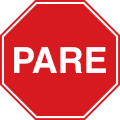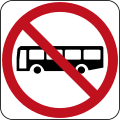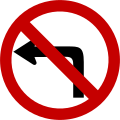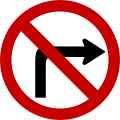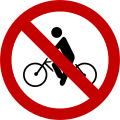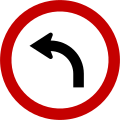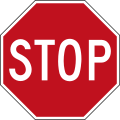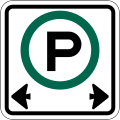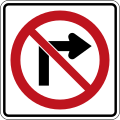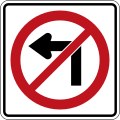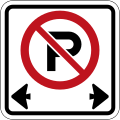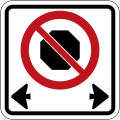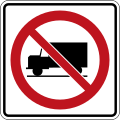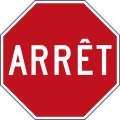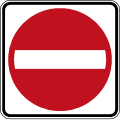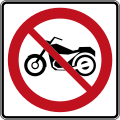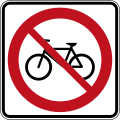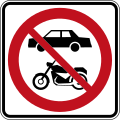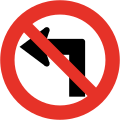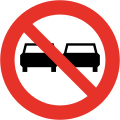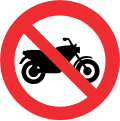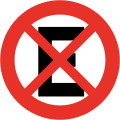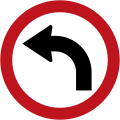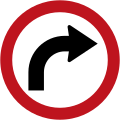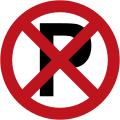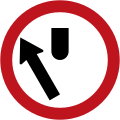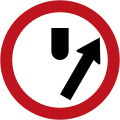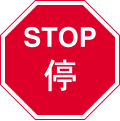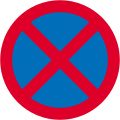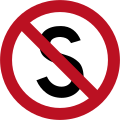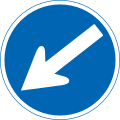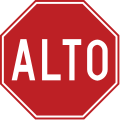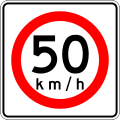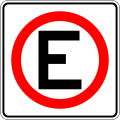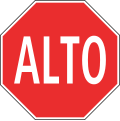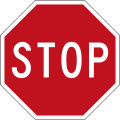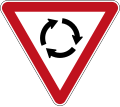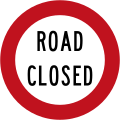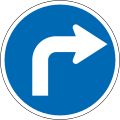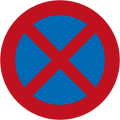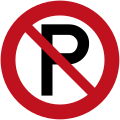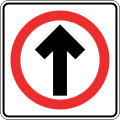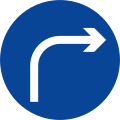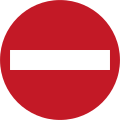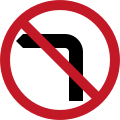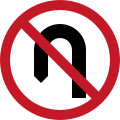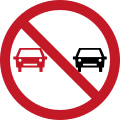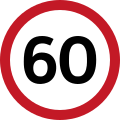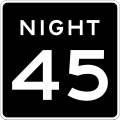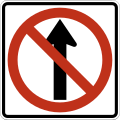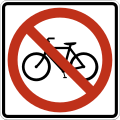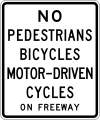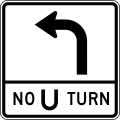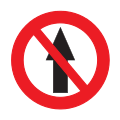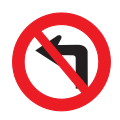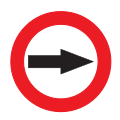Regulatory sign
One type of regulatory signs are traffic signs intended to instruct road users on what they must or should do (or not do) under a given set of circumstances. Other types may be signs located on streets and in parking lots having to do with parking, signs in public parks and on beaches or on or in architectural facilities prohibiting specific types of activities. The term regulatory sign describes a range of signs that are used to indicate or reinforce traffic laws, regulations or requirements which apply either at all times or at specified times or places upon a street or highway, the disregard of which may constitute a violation, or signs in general that regulate public behavior in places open to the public.
Examples of non-traffic types of regulatory signs might be tow-away signs for vehicles without disabled parking stickers or no-smoking signs where there are laws prohibiting smoking.
Argentina
-
No straight ahead
-
Do not enter
-
No motor vehicles
-
No motorcycles
-
No bicycles
-
No heavy vehicles
-
No left turn
-
No right turn
-
No U-turn
-
No overtaking
-
No parking
-
No stopping
-
Maximum speed
-
Minimum speed
-
Parking permitted
-
Turn right ahead
-
Turn left ahead
-
Turn right
-
Turn left
-
Straight ahead
-
Keep right
-
Keep left
-
Stop
-
Yield
-
Yield to oncoming traffic
Australia
-
No entry
-
No U-turn
-
No left turn
-
No right turn
-
Pedestrian crossing
-
Safety zone
-
Speed limit
-
No stopping
-
No parking
-
Clearway
-
No buses
-
No trucks
-
No bicycles
-
No pedestrians
Brazil
-
Stop
-
Yield
-
No entry
-
No left turn
-
No right turn
-
No U-turn
-
No parking
-
Parking
-
No stopping
-
No overtaking
-
No heavy goods vehicles
-
No motor vehicles
-
No bicycles
-
Speed limit
-
Turn right
-
Pass on right
-
Left turn ahead
-
Right turn ahead
-
Left turn or straight ahead
-
Right turn straight ahead
-
Straight ahead
-
Roundabout
Canada
-
Stop
-
Yield
-
Yield at roundabout
-
Do not enter
-
No right turn
-
No left turn
-
No overtaking
-
Overtaking permitted
-
No parking
-
Parking permitted
-
No stopping
Ontario
-
Stop
-
Yield
-
Speed limit
-
No straight ahead
-
No right turn
-
No left turn
-
No straight ahead or right turn
-
No straight ahead or left turn
-
No turns
-
No U-turn
-
Do not enter
-
Do not enter, wrong way
-
One way (right)
-
One way (left)
-
Keep right
-
Through traffic keep right
-
No overtaking
-
Slower traffic keep right
-
Overtaking permitted
-
This lane must turn left
-
This lane must turn right
-
This lane must straight ahead or turn left
-
This lane must straight ahead or turn right
-
This lane must turn left or right
-
This lane must straight ahead or turn left or right
-
This lane must straight ahead
-
Turn left in median turning lane
-
Turn left in centre lane only
-
No parking
-
No parking (Monday to Friday)
-
Parking permitted (2 hour parking)
-
Parking permitted (30 minute parking)
-
No standing
-
No standing (Monday to Friday)
-
No stopping
-
No stopping (Monday to Friday)
-
No heavy vehicles
-
No bicycles
-
No pedestrians and bicycles
-
Yield to oncoming traffic
Quebec
-
Stop
-
Yield
-
Yield at roundabout
-
Yield to oncoming traffic
-
Do not enter
-
Minimum speed
-
Maximum speed
-
One way (left)
-
One way (right)
-
Keep left
-
Keep right
-
This lane must straight ahead
-
This lane must turn left
-
This lane must turn right
-
This lane must straight ahead or turn left
-
This lane must straight ahead or turn right
-
This lane must turn left or right
-
Turn left in median turning lane
-
Straight ahead and turn left, the other left lane must turn
-
Straight ahead and turn right, the other right lane must turn
-
Straight ahead only
-
Turn left only
-
Turn right only
-
Straight ahead or turn left only
-
Straight ahead or turn right only
-
Turn left or right
-
No U-turn
-
No left turn
-
No right turn
-
No straight ahead
-
No heavy vehicles
-
No motor vehicles
-
No motorcycles
-
No bicycles
-
No motor vehicles and motorcycles
-
No motor vehicles and bicycles
-
No pedestrians and motorcycles
-
No pedestrians and bicycles
-
No overtaking
-
No parking
-
No parking, disabled
-
Parking permitted
-
No stopping
Chile
-
Yield
-
Stop
-
No entry
-
No left turn
-
No right turn
-
No U-turn
-
No overtaking
-
No heavy vehicles
-
No motor vehicles
-
No bicycles
-
No motorcycles
-
No parking
-
No stopping
-
Maximum speed
-
Minimum speed
-
One way (right)
-
One way (left)
-
Turn right only
-
Turn left only
-
Give preference to vehicles coming from opposite direction
-
Pass on right
-
Pass on left
China
-
Stop
-
No stopping
-
No parking
-
Keep right
-
Pedestrian path
Colombia
-
Stop
-
Yield
-
Straight ahead
-
No entry
-
Left turn
-
No left turn
-
Right turn
-
No right turn
-
No U-turn
-
No motor vehicles
-
No lorries
-
No bicycles
-
No motorcycles
-
No overtaking
-
No parking
-
No stopping
-
Maximum speed
-
Minimum speed
-
One way (right)
-
One way (left)
-
Pass on left
-
Pass on right
France
-
Stop
-
No parking
-
No stopping
-
Keep right
-
Pedestrian path
Hong Kong
-
Stop
-
Keep left
-
No stopping
-
No parking
Indonesia
-
Stop
-
Yield
-
Toll plaza
-
No entry
-
No stopping
-
No parking
-
No left turn
-
No U-turn
-
No right turn or U-turn
-
Keep left
-
Pass either side
-
Motorcycles only
-
Pedestrians only
-
Toll road
Ireland
-
Keep left
-
Pass either side
-
Clearway
-
No left turn
-
No U-turn
-
No parking
-
Yield
-
Stop
-
No entry
Japan
-
Keep left
-
No stopping
-
No parking
-
Pedestrians only
-
Stop
Malaysia
-
Stop
-
Give way
-
No entry
-
No U-turn
-
No left turn
-
No parking
-
No stopping
-
Keep left
Mexico
-
Stop
-
Yield
-
Speed limit
-
Turn right
-
Keep right at roundabout
-
Keep right
-
Turn left
-
No overtaking
-
No stopping
-
Parking permitted
-
No parking
-
No right turn
-
No left turn
-
No U-turn
-
Do not enter
-
No bicycles
-
No heavy vehicles
Jalisco
-
Stop
-
Yield
-
Speed limit
-
Turn right
-
Keep right at roundabout
-
Keep right
-
Turn left
-
No overtaking
-
No stopping
-
Parking permitted
-
No parking
-
No right turn
-
No left turn
-
No U-turn
-
No straight ahead
-
No bicycles
-
No heavy vehicles
-
Do not enter
New Zealand
-
Speed limit
-
Speed limit derestriction
-
Stop
-
Give way
-
Give way at roundabout
-
Give way to oncoming vehicles
-
Priority over oncoming vehicles
-
No left turn
-
No right turn
-
No U-turn
-
No entry
-
Road closed
-
Proceed straight ahead
-
Turn right
-
Keep left
-
No heavy vehicles
-
No stopping
-
No parking
Panama
-
Stop
-
Yield
-
Straight ahead
-
No straight ahead
-
No left turn
-
No right turn
-
No U-turn
-
Parking permitted
-
No parking
-
No overtaking
-
No motor vehicles
-
No bicycles
-
No stopping
-
Speed limit
-
Turn right
-
Keep right
-
Left turn ahead
-
Right turn ahead
-
No motorcycles
-
No entry
-
One way
Peru
-
Stop
-
Yield
-
Straight ahead
-
No straight ahead
-
Left turn
-
This lane must turn left
-
This lane must straight ahead or turn left
-
Straight ahead and turn left, the other left lane must turn
-
Turn left in median turning lane
-
No left turn
-
Right turn
-
No right turn
-
No U-turn
-
Turn right
-
One way
-
No overtaking
-
No motor vehicles
-
No lorries
-
No bicycles
-
No motorcycles
-
Parking permitted
-
No parking
-
No stopping
-
Speed limit
-
Maximum/minimum speed
-
No entry
Philippines
-
Stop
-
Give way
-
Proceed straight
-
Proceed straight (No turns)
-
Turn right
-
Turn left
-
Turn right (One-way street)
-
Turn left (One-way street)
-
Keep right
-
Keep left
-
Pass either side
-
All traffic must turn right
-
All traffic must turn left
-
Merging traffic
-
Two-way traffic
-
No entry
-
No bicycles
-
No trucks
-
No pedestrians
-
No pedestrians, use overpass
-
No pedestrians, use pedestrian crossing
-
No right turn
-
No left turn
-
No U-turn
-
No overtaking
-
Speed limit
-
Speed limit derestriction
-
Maximum speed derestriction
-
Minimum speed
-
No parking
-
Restricted parking (2 hours parking)
-
Restricted loading (loading zone)
-
Loading and unloading zone
-
No waiting anytime
-
No loading and unloading anytime
-
No stopping anytime
-
No parking, bus stop
-
Do not block intersection
-
No blowing of horns
-
Width limit
-
Height limit
-
Weight limit
-
Length limit
-
Pedestrian crossing
-
School crossing
-
Bicycle lane
Taiwan
-
Stop
-
Keep right
-
Pedestrian only
-
No parking
-
No stopping
United Kingdom
-
Stop
-
Keep left
-
No parking
-
No stopping
United States
-
Stop
-
Yield
-
Yield to oncoming traffic
-
Yield at roundabout
-
Yield here to pedestrians (left)
-
Yield here to pedestrians (right)
-
Yield to pedestrians within crosswalk
-
Yield to pedestrians
-
Speed limit
-
Night speed limit
-
Minimum speed limit
-
Maximum/minimum speed
-
No right turn
-
No left turn
-
No turns
-
No U-turn
-
Right turn only
-
Left turn only
-
Straight ahead only
-
Straight ahead or right turn only
-
Straight ahead or left turn only
-
Right lane must turn right
-
Left lane must turn left
-
Straight ahead and turn right, the other right lane must turn
-
Straight ahead and turn left, the other left lane must turn
-
Turn left in median turning lane
-
Turn left in centre lane only
-
No left turn or U-turn
-
Begin right turn lane
-
Begin left turn lane
-
No straight ahead
-
Do Not pass
-
Pass with care
-
Slower traffic keep right
-
Keep right
-
Keep left
-
Keep right except to pass
-
Do not enter
-
Wrong way
-
No heavy vehicles
-
No motor vehicles
-
No commercial vehicles
-
No bicycles
-
No non-motorized traffic
-
No motor-driven cycles
-
No pedestrians, bicycles, motor-driven cycles
-
No pedestrians or bicycles
-
Authorised vehicles only
-
One way (right)
-
One way (left)
-
Divided highway at crossroads
-
Divided highway at T-junctions
-
Roundabout directional arrow (2 chevrons)
-
Roundabout directional arrow (3 chevrons)
-
Roundabout directional arrow (4 chevrons)
-
Begin one way
-
End one way
-
No parking
-
Pay parking
-
No parking at bus stop
-
Parking permitted
California
-
Speed zone ahead
-
Tow-away zone, no stopping anytime
-
No parking anytime
-
No stopping anytime
-
Photo enforced by traffic signals
-
Turn left only, no U-turn
-
Disabled parking only
Uruguay
-
Stop
-
Yield
-
No straight ahead
-
No left turn
-
No right turn
-
No U-turn
-
No parking
-
Parking permitted
-
No stopping
-
No overtaking
-
No heavy goods vehicles
-
No motor vehicles
-
No bicycles
-
Speed limit
-
Turn right
-
Left turn ahead
-
Right turn ahead
-
Straight ahead
See also
References
- Federal Highway Administration. "Section 1A.13 Definitions of Words and Phrases in This Manual". Manual on Uniform Traffic Control Devices (html or pdf) (2003 ed.). Washington, DC. p. 1A-12. Retrieved 2009-03-01.
Regulatory Sign—a sign that gives notice to road users of traffic laws or regulations.
{{cite book}}: Cite has empty unknown parameters:|1=,|laysummary=,|laydate=, and|lastauthoramp=(help); External link in|chapterurl=|chapterurl=ignored (|chapter-url=suggested) (help)























